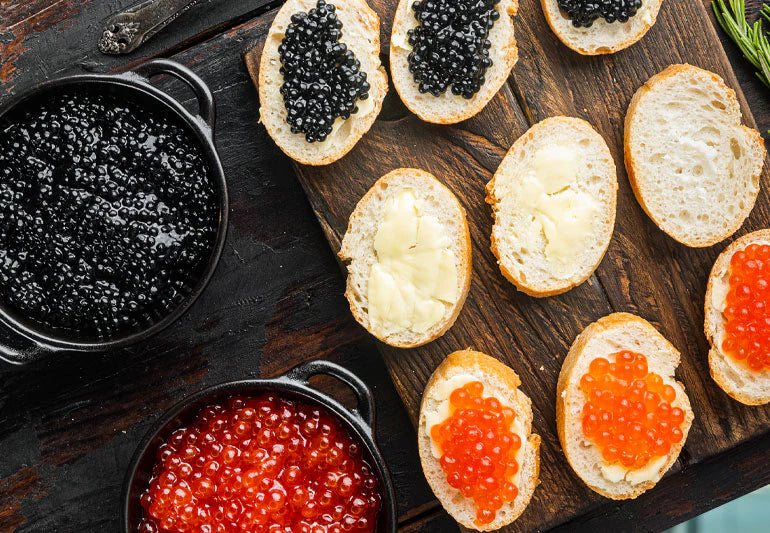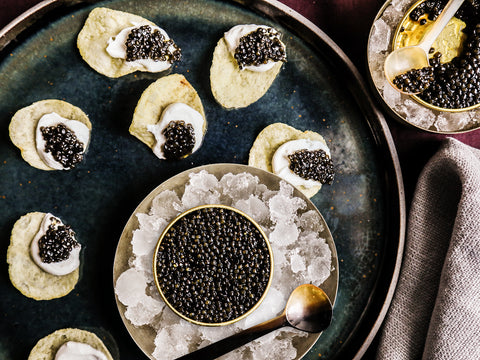
Caviar is a delicacy that has gained massive popularity in the last few years. In the world of food, it’s regarded as one of the most exquisite types of food for people who enjoy eating fish roe.
If you're new to the caviar party, you probably want to know: What is roe fish? What are the types of roe out there? And what kind of fish do they come from?
In this post, foodie experts at Bester Caviar will tell you all you need to know on this subject. Read on to find out!
What are the types of roes?
It’s easy to get swamped with the different types of fish eggs (roes) especially if you’re new to the treat. But not to worry, here’s an easy way to start trying out this sweet delicacy:
Fish roe vs caviar can be grouped into two classes: The Sturgeon roes and the Non-sturgeon roes. But first, What are fish eggs or roe? Roe is a general name for the eggs of aquatic animals.
And What's Caviar?
Caviar is the more special roe variety from sturgeon fishes, and What's the difference between caviar and roe? Caviar is often considered a luxury delicacy because it must be obtained from a high-quality sturgeon and can elevate your dining experience. An easy way to think of the difference between fish roe and caviar is while roes encompass all fish eggs, caviar is the roe of only sturgeon fishes.

The Sturgeon Roes or Caviar includes:
Beluga, osetra, and sevruga are the most known and valued black caviar types sourced from wild Caspian and Black Sea sturgeons (And now reared in fish farms).
The Non-Sturgeon Roes are:
Sourcing and producing caviar is very expensive and is how roes from different fish species came into play. At best, they are cheaper substitutes for caviar with a briny taste and wide flavor profile. However, when sourced from reputable sources like Bester Caviar you may be surprised by its amazing taste and quality. Here are some of the common fish roes:
Hence, the types of roes are the Sturgeon roes (Beluga, osetra, sevruga, and sterlet) and the Non-sturgeon roes (Salmon, paddlefish, trout, masago, and tobiko, amongst others).
The difference between caviar and fish eggs lies in their quality, taste, and price range. In the coming paragraphs, you will get to learn more about black caviar and why they are premium compared to its cheaper substitutes.
Beluga
Beluga is the most expensive roe and it comes from the Caspian Sea. It is grey-colored and has a rich, buttery flavor and large beads. To buy Beluga in the US, you’ll need to shell out about $800/oz. Beluga import is currently banned in the U.S, and only one company is allowed to raise Beluga species in Florida and sell its roe. However, you can buy the Royal Beluga hybrid if you’re looking for the closest grade to Beluga in the U.S at a much lower cost.
Osetra
Osetra roe has a similar flavor profile to Beluga but it's darker in color because it's from a different species of sturgeon than Beluga. Osetra is a type of sturgeon that can still be quite expensive when compared to other types of roe.
This type of roe is found on the Black Sea coast of Russia, Ukraine, and Greece. It has a rich nutty flavor and is known for its famous pop. Premium suppliers like Bester Caviar offer exquisite varieties of Osetra caviar.
Sevruga
Sevruga has been harvested from the Amur River in Russia since ancient times. The sevruga fish has a pinkish color due to its high level of lipids.
The fish roe of Sevruga has earthy and briny flavor and smaller beads. It's often served as an appetizer or snack, especially in the Mediterranean diet.

If you’re looking for the best caviar which fish is sturgeon, then you should try it at a restaurant where you know they serve great caviar dishes. If you prefer to have a romantic dinner at home then look for a trusted supplier to buy caviar.
What's the difference between caviar and roe?
Caviar is the salt-cured roe of a sturgeon fish. It's very expensive and is usually served as an appetizer or a meal supplement. Fish roe, on the other hand, refers to ordinary eggs of any kind of fish.
The term roe may also refer to a meal made from other seafood such as shrimps or(both are synonyms}. Preparation of this delicacy is by boiling them in water until they become tender.
Wondering what sea does caviar come from? As established earlier, the sturgeon fish makes its home predominantly in the Caspian Sea but also lives in the Black Sea and some areas in Europe and Asia.
Nowadays all caviar is farm-raised, and wild caviar is illegal for trade…
Savor the treat of the finest eggs of sturgeon fish

If you're a fan of caviar (aren’t we all?), then you're probably pretty familiar with the term sturgeon. What you might not know is that sometimes more than just one fish egg type is used for caviar. Sturgeon family counts 27 species like Beluga, Osetra, Kaluga, Sevruga, Sterlet and more. Only sturgeon species produce caviar, other fish types produce roe. From sturgeon to salmon and even trout, the taste can vary greatly depending upon which fish egg you prefer.
If you want a recommendation on the best caviar, we’d say go for sturgeon caviar. Once you get to taste caviar from Osetra and Beluga eggs, you’ll not want to go back to the lower grades of caviar. One way to be sure you're getting the finest caviar is to shop at a certified online store like Bester Caviar.
Conclusion
In conclusion, caviar, a delicacy made from the fully ripe eggs of specific fish, has become a highly sought-after treat in recent years. The primary source of caviar is the sturgeon fish, with different species yielding various types of caviar, such as Beluga, Osetra, and Sevruga.
Let's remember the important questions.
What fish does caviar come from?
Caviar comes from the eggs of the sturgeon fish. There are various sturgeon species, each producing distinct types of caviar, known for their unique flavors, textures, and appearances.
Is caviar fish eggs?
Yes, caviar is indeed fish eggs. However, it's essential to note that not all fish eggs qualify as caviar. Caviar specifically refers to the salt-cured roe of the sturgeon fish.
What fish produces the best caviar?
The sturgeon family, consisting of species like Beluga, Osetra, Sevruga, and others, produces caviar. The choice of the "best" caviar depends on individual preferences, with Beluga known for its buttery flavor and large beads, Osetra for its rich nutty taste, and Sevruga for its earthy and briny profile.
What is the difference between fish roe and caviar?
While both fish roe and caviar are derived from fish eggs, the distinction lies in the type of fish and the curing process. Fish roe refers to ordinary eggs of any fish, whereas caviar specifically denotes the salt-cured roe of sturgeon fish. The curing process gives caviar its unique flavor, texture, and richness, setting it apart from regular fish roe.
In the modern context, all caviar is farm-raised, with wild caviar being illegal for trade. Sturgeon, predominantly found in the Caspian Sea but also in the Black Sea and certain areas in Europe and Asia, serves as the primary source for caviar production.
For connoisseurs seeking the best caviar experience, exploring varieties from different sturgeon species like Beluga, Osetra, and Sevruga is recommended. The taste can vary significantly, providing a diverse and luxurious culinary experience. So, if you're a caviar enthusiast, savor the treat of the finest sturgeon fish eggs and elevate your gastronomic experience.
Written by Inna Polutska
